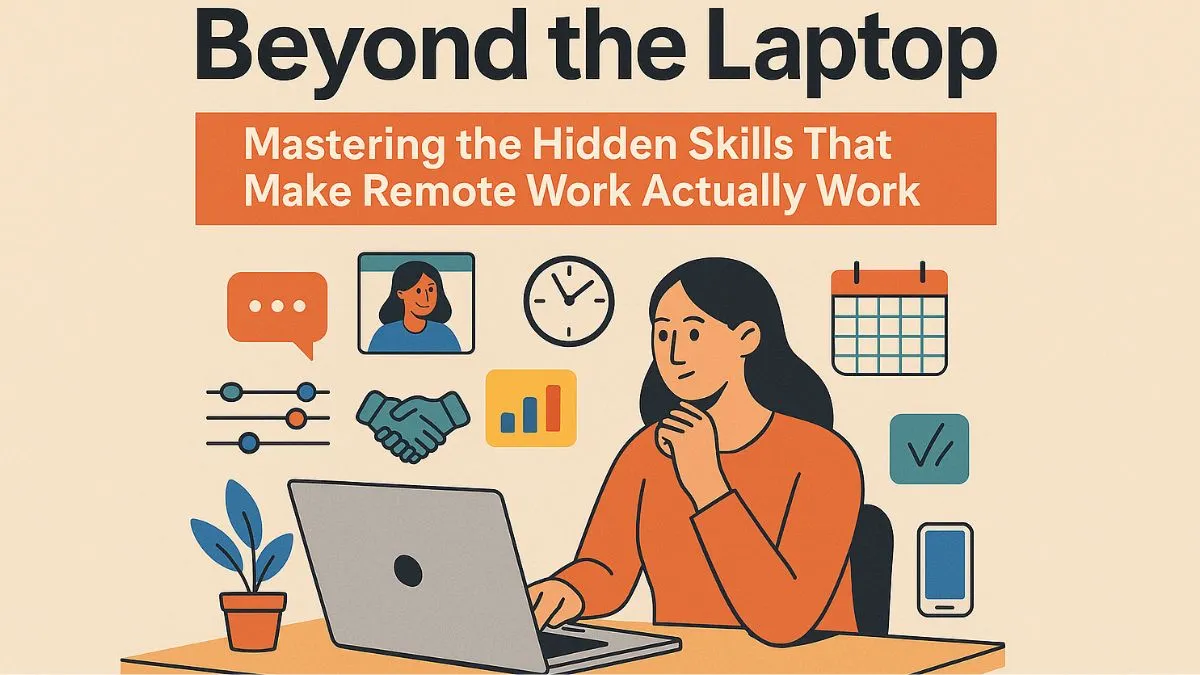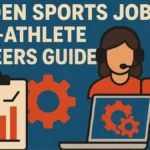Beyond the Laptop: Mastering the Hidden Skills That Make Remote Work Actually Work
Remember that dizzying rush in early 2020? Overnight, our commutes vanished. Work became pyjama-optional. We traded office chatter for Slack pings. It felt like freedom! Fast forward to today. That initial thrill? For many, it’s curdled into something else: Zoom fatigue, blurred work-life boundaries that feel more like a smudge than a line, and a nagging sense of isolation. You might be crushing your tasks, but why does it feel like you’re running on a treadmill nobody sees? The harsh truth is this: simply doing your job from home isn’t the same as thriving in a remote career. The rules changed, and many of us are still playing catch-up.
The biggest misconception? Thinking remote work is just about location. Spoiler alert: It’s not. It’s a fundamentally different way of operating, demanding a unique set of skills beyond your core job expertise. Companies aren’t just looking for someone who *can* work remotely; they’re hunting for people who excel at it. Let’s unpack the real superpowers you need to build a fulfilling, successful remote career in 2024 and beyond.
Skill #1: Communication: Your Digital Megaphone (and Ear Trumpet)
Picture this: Riya, a talented graphic designer in Pune, spends days crafting a brilliant campaign concept. She emails it over, confident it’s a winner. Silence. Two days later, a confused message: “This looks good, but it’s not quite what we discussed?” Turns out, a key clarification got buried in a chaotic Slack thread. Her work was stellar; her communication wasn’t. Remote work amplifies miscommunication like a faulty microphone.
Why it’s non-negotiable: Without body language, quick desk drop-bys, or overheard conversations, clarity becomes your oxygen. Ambiguity is the enemy.
Actionable Tactics:
- Over-Clarify, Don’t Assume: “Just to confirm, by ‘modern aesthetic,’ you mean minimalist with bold typography, similar to X reference, right?” Rephrase requests in your own words.
- Master the Medium: Complex feedback? Jump on a quick call. Simple update? Use Slack/Teams. Need a paper trail? Email. Don’t default to one channel.
- Become a Proactive Status Updater: Don’t vanish into the work void. A simple “Blocked on X, waiting for Y input” or “First draft 80% done, aiming for EOD” in your team channel works wonders. Tools like Digital Smart Careers often highlight this as a top trait in remote hires.
- Listen Actively (Especially on Calls): Paraphrase: “So, the main priority is X, and Y is the stretch goal?”
Skill #2: Self-Management: Building Your Own Office (and Boss)
Meet Arjun in Bangalore. His home “office” is the corner of his living room. The fridge whispers temptations. His phone buzzes constantly. The laundry pile stares accusingly. Some days, he’s hyper-productive by 10 AM. Others, he’s scrolling endlessly at 3 PM, feeling guilty and scattered. Without external structure, your internal discipline is the only thing standing between you and chaos.
Why it’s non-negotiable: Remote work grants autonomy, but it demands responsibility. Companies need to trust you’ll deliver without someone physically watching.
Actionable Tactics:
- Ritualize Your Start & End: Mimic a commute. Walk around the block before logging on. Shut down your laptop, then do a 5-minute meditation or journaling session. Signal to your brain: “Work is done.”
- Time Block Like a Tyrant (But a Kind One): Use your calendar aggressively. Block “Deep Work – Project X,” “Email Triage,” even “Lunch Break.” Protect these blocks fiercely.
- Designate a Sacred Space: Even if it’s just a specific chair and a foldable desk. Your brain needs a physical cue for “work mode.”
- Embrace the Power of “No”: Protect your focus time. “I can tackle that after my 2 PM deep work block, is that okay?”
Skill #3: Digital Tool Fluency: More Than Just Knowing Zoom
Priya, a project manager in Mumbai, spends hours every week manually compiling status updates from emails, Slack messages, and disparate Google Docs. She feels like an admin clerk, not a leader. Her team is frustrated by the lack of visibility. The problem? Underutilizing the tech stack designed to make remote collaboration seamless.
Why it’s non-negotiable: Remote work runs on digital infrastructure. Being clumsy with tools slows everyone down and creates friction. It’s like showing up to a construction site without knowing how to use a hammer.
Actionable Tactics:
- Go Beyond Basic Proficiency: Don’t just know *how* to use your project management tool (Asana, Jira, Trello, ClickUp). Learn to automate tasks, create custom views, generate insightful reports. Invest 30 mins a week exploring advanced features.
- Master Asynchronous Communication Tools: Use Loom for quick video walkthroughs instead of scheduling a call. Organize complex discussions in threaded comments on documents (Notion, Confluence) rather than endless email chains.
- Become a Security Ninja: Understand VPNs, password managers (like LastPass/Bitwarden), and company data policies. Protecting company data remotely is paramount. Resources like Digital Smart Careers often offer quick guides on essential remote tech hygiene.
Skill 4: Proactive Relationship Building: Networking Without the Watercooler
Sanjay, a skilled developer in Hyderabad, joined his fully remote company 6 months ago. He delivers excellent code but feels invisible. He doesn’t know who to ask for help beyond his direct manager. Promotions seem to go to people who “know people.” He’s experiencing the remote invisibility trap.
Why it’s non-negotiable: Out of sight doesn’t have to mean out of mind. Career growth, collaboration, and even job security often hinge on the strength of your professional relationships. You need to build trust and visibility intentionally.
Actionable Tactics:
- Schedule Virtual Coffee Chats (Religiously): Block 15-20 mins weekly to connect with someone outside your immediate team. “Hey [Name], I saw your work on [Project], really interesting! Would you have 15 mins for a virtual coffee this week to chat about it?”
- Be Generously Visible: Share useful articles/resources in relevant channels. Give public kudos to colleagues on Slack/Teams when they help you. Contribute thoughtfully in virtual meetings – don’t just be a silent avatar.
- Leverage On-Sites (If Possible): If your company has occasional meet-ups, GO. Use that time to build genuine connections.
- Find Your Champions: Identify mentors or senior leaders. Ask for their advice periodically. Update them (briefly!) on your achievements. This is where strategic use of platforms highlighted by Digital Smart Careers can help map internal networks.
Skill #5: Boundary Setting & Wellbeing: Your Remote Sustainability Plan
Meera, a customer support lead in Delhi, feels permanently “on.” Her laptop is always open. Notifications ping late into the night. Weekends blur into work catch-up. She’s burning out, and her productivity and patience are plummeting. The “always-on” culture is the silent killer of remote potential.
Why it’s non-negotiable: Burnout is real, and remote work makes it insidious. Protecting your energy isn’t selfish; it’s essential for long-term performance and sanity. Companies value sustainable contributors.
Actionable Tactics:
- Physically Separate When Possible: Shut the office door. Put the laptop in a drawer at night. Create physical barriers.
- Master Notification Management: Turn off *all* non-critical work notifications outside core hours. Use “Do Not Disturb” modes aggressively. Set clear expectations: “I respond to Slack between 9-6 IST.”
- Schedule Non-Negotiable Breaks & Time Off: Block lunch breaks in your calendar. Actually take them – away from screens. Use your vacation days fully and unapologetically. Disconnect completely.
- Communicate Your Boundaries Clearly & Kindly: “Just a heads-up, I log off at 6:30 PM IST to focus on family. I’ll pick this up first thing tomorrow!” Most reasonable teams respect clear boundaries.
Building these skills isn’t about becoming a remote work robot. It’s about reclaiming control, amplifying your impact, and finding genuine satisfaction in your career, no matter where your desk is. It transforms remote work from just a perk into a powerful platform for professional growth and personal well-being. You stop feeling like you’re constantly swimming against the current and start navigating with purpose and confidence.
Remember, excelling remotely isn’t magic. It’s a deliberate practice. It’s choosing clarity over assumption, structure over chaos, intentional connection over isolation, and sustainable energy over burnout. It’s about proving that great work isn’t defined by a zip code, but by the skills, discipline, and heart you bring to it every single day. You have the talent. Now, master the environment. Your most productive, balanced, and fulfilling remote career is absolutely within reach.
Your Remote Work Success Toolkit
FAQs:
- Q: How do I prove I have these skills in a job interview?
A: Use the STAR method! Describe a Situation (e.g., “Working remotely on a complex project…”), the Task (“…needed clear communication across time zones…”), the Action you took (“…I implemented daily async video updates via Loom and a shared Trello board…”), and the Result (“…reduced miscommunication by 70% and delivered ahead of schedule”). - Q: I feel isolated working remotely. How can I connect better?
A: Go beyond work talk! Initiate casual channels on Slack/Teams (#pet-corner, #weekend-plans). Join (or start!) virtual interest groups within the company (book club, gaming). Be the one to suggest a 5-min non-work chat at the start of team calls. - Q: My manager expects me to be always available. How do I push back?
A: Frame it positively! Schedule a chat: “I want to ensure I’m delivering my best work. To maintain focus and avoid burnout, I propose core hours of [X-Y] IST for real-time collaboration. Outside that, I’ll manage async communication and ensure urgent issues are addressed, but my response time may be slower. This will help me stay energized and productive.” Propose solutions, not just problems. - Q: What if my company doesn’t provide good remote tools?
A: Advocate for them! Research cost-effective options (many have free tiers). Present the benefits clearly: “Adopting [Tool X] could save our team an estimated [Y] hours per week on [Task] by streamlining [Process].” Show the ROI.
Essential Apps & Tools:
- Focus & Time Management: Forest (gamified focus), Toggl Track (time tracking), RescueTime (activity insights), Focus@Will (concentration music).
- Communication & Collaboration: Slack/Teams (messaging), Loom (async video), Miro/Mural (virtual whiteboarding), Notion/Confluence (documentation/wiki).
- Project & Task Management: ClickUp, Asana, Trello, Jira (choose based on complexity).
5 Quick Wins You Can Do Today:
- Audit Your Notifications: Right now, turn off *all* non-critical work app notifications on your phone. Be ruthless.
- Block Your Power Hour: Find your most focused time tomorrow. Block 60 mins in your calendar as “Deep Work – UNAVAILABLE.” Guard it.
- Schedule One Virtual Coffee: Reach out to one colleague (not on your immediate team) and book a 15-min virtual chat for this week. Just connect.
- Define Your “End of Day” Ritual: Choose one specific action you’ll do *every day* to signal work is done (close laptop & put in bag, walk around the block, change clothes). Start tonight.
- Learn One New Tool Feature: Pick one core tool you use (Slack, Teams, Asana, etc.). Spend 10 mins exploring its help docs or a YouTube tutorial. Find one new feature to try tomorrow.
Mastering the art of remote work is an ongoing journey, not a destination. Platforms like Digital Smart Careers consistently emphasize that the most successful remote professionals are those who proactively develop these meta-skills. Start small, implement one change, build momentum, and watch your remote career truly flourish.




